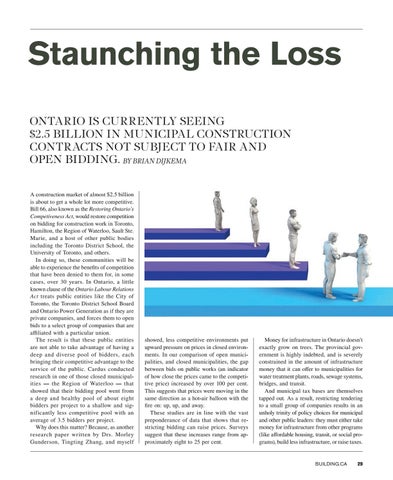Staunching the Loss Ontario is currently seeing $2.5 billion in municipal construction contracts not subject to fair and open bidding. By Brian Dijkema A construction market of almost $2.5 billion is about to get a whole lot more competitive. Bill 66, also known as the Restoring Ontario’s Competiveness Act, would restore competition on bidding for construction work in Toronto, Hamilton, the Region of Waterloo, Sault Ste. Marie, and a host of other public bodies including the Toronto District School, the University of Toronto, and others. In doing so, these communities will be able to experience the benefits of competition that have been denied to them for, in some cases, over 30 years. In Ontario, a little known clause of the Ontario Labour Relations Act treats public entities like the City of Toronto, the Toronto District School Board and Ontario Power Generation as if they are private companies, and forces them to open bids to a select group of companies that are affiliated with a particular union. The result is that these public entities are not able to take advantage of having a deep and diverse pool of bidders, each bringing their competitive advantage to the service of the public. Cardus conducted research in one of those closed municipalities — the Region of Waterloo — that showed that their bidding pool went from a deep and healthy pool of about eight bidders per project to a shallow and significantly less competitive pool with an average of 3.5 bidders per project. Why does this matter? Because, as another research paper written by Drs. Morley Gunderson, Tingting Zhang, and myself
showed, less competitive environments put upward pressure on prices in closed environments. In our comparison of open municipalities, and closed municipalities, the gap between bids on public works (an indicator of how close the prices came to the competitive price) increased by over 100 per cent. This suggests that prices were moving in the same direction as a hot-air balloon with the fire on: up, up, and away. These studies are in line with the vast preponderance of data that shows that restricting bidding can raise prices. Surveys suggest that these increases range from approximately eight to 25 per cent.
Money for infrastructure in Ontario doesn’t exactly grow on trees. The provincial government is highly indebted, and is severely constrained in the amount of infrastructure money that it can offer to municipalities for water treatment plants, roads, sewage systems, bridges, and transit. And municipal tax bases are themselves tapped out. As a result, restricting tendering to a small group of companies results in an unholy trinity of policy choices for municipal and other public leaders: they must either take money for infrastructure from other programs (like affordable housing, transit, or social programs), build less infrastructure, or raise taxes.
Building.ca
BLD MayApr 19.indd 29
29
2019-04-03 2:07 PM
